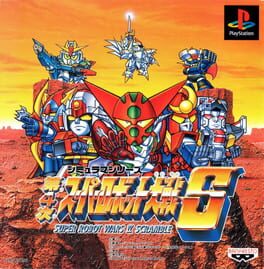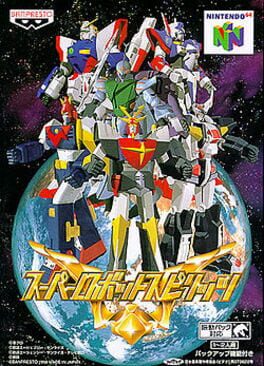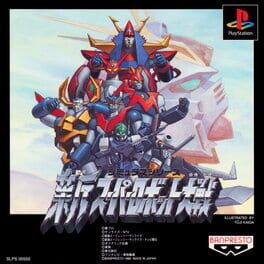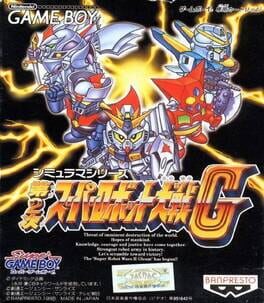Reviews View More
With this completed, so ends my recent series of playing through the original 4 SRW games (in one form or another). However, given that my playthroughs of SRW 2, 3, and EX were via their 1999 remakes, this is technically the oldest SRW game I’ve played, being more or less a direct port of the Super Famicom original with a few new aesthetic touches here and there. I got the best ending playing as a male real robot pilot, and it took me probably around 60 or 70 hours on original hardware.
This is the original conclusion (before it was remade in F and F Final) of what is now known as the Divine Crusaders SRW games. It’s the first to let you have a player avatar character, though you don’t play a very major role in the story, and it pits our heroes against familiar Gundam villains (those still remaining from prior games, at least), as well as finally letting us fight Mazinger villains. We also get several new series adapted here (L-Gaim, Dancouga, Tosho Daimos, and Zambot 3 among them), and fighting the L-Gaim antagonists in particular takes up a sizeable part of the narrative. Once again, this is an early SRW game, so it’s not exactly high art we’re dealing with here, but it’s still charming, funny, and compelling in the same way most of the early WinkySoft era SRW games are. Even though the narrative is kinda getting to the point where we have a bit too much bloat with how many characters we’re dealing with (with Dancouga’s antagonists being entirely absent, and Daimos and Zambot’s being so minor they may as well not even be here), it doesn’t really harm the overall quality or flow of the narrative for the more lighthearted purpose it’s presented with.
Mechanically, while it’s still pretty recognizably a SRW game as an SRPG, this game absolutely shows its age and then some, as this is another SRW game (as so many of the early ones were) that’s bringing a LOT of “firsts” to the table. As previously mentioned, this is the first SRW game to have a player avatar character with their own original mech. This is also the first game to have the ability to select counterattacks as well as the first to have pilot passive skills (such as Newtype or Parry), rather than just mech passive skills. Most importantly, this is also the first game to have equippable items. These items aren’t gotten from defeated enemies as in most all later games, but instead are hidden in invisible spots on the ground that you either need to intuit (or guess) are there, or you need to use the Search spirit ability to learn that they’re there. This invisible items thing was easily the part of the game that I detested the most, and it’s such a bummer to know that this isn’t the only game in the series that does it Xp.
Aside from those new mechanics, the game on the whole is remarkably easy (likely as a response to how difficult the original version of SRW 3 was, from what I understand). Units can gain levels remarkably quickly if they’re killing enemies that are a higher level than them, many units (particularly multi-pilot super robots like the Dancouga or the Combattler) have VERY good spreads of spirit abilities to help them really throw their weight around, and enemies themselves just generally trend to be quite weak (most notably in how no unnamed enemy has any parry or shield skills, making them very easy to mop up). There are two or three missions I found quite hard, but overall, if you generally keep most folks leveled up so the team split in the last leg of the game has solid fighters in both teams, this is probably the easiest SRW game I’ve played, if not very close to it. The only really pain in the butt Old Game Problem that this 1995 SRPG somehow has is that ammo refillers and healers DON’T gain EXP from healing or refilling ammo. This isn’t a huge deal, but it is an annoyance in that your support units are either going to be largely ignored and/or under leveled as they’re just too risky to deploy most of the time.
Presentation-wise, this is quite a nice looking game compared to other WinkySoft PS1 SRW games, but it also definitely shows how much of a Super Famicom game it is. The graphics are much effectively identical, though the soundtrack is more early PS1 than it is late SFC (though an interesting audio note is that your robot’s themes only play when they’re attacking, and not when they’re counterattacking as well like they do in basically every game after this). The most noticeable addition between the two versions is that 4S has voice acting during battle scenes, but only for some characters. It’s generally just the main protagonists of the included series, with some original characters and side characters from especially the new additions to SRW getting voices as well, but not all the time. Grendizer’s pilot, who had been in the previous 3 SRW games is unvoiced, and not a single character from new addition Zambot 3, not even its main character, are voiced. This is despite some characters who aren’t even recruitable (original character Gilliam who is only ever a friendly NPC) and some absurdly hard to find/recruit characters (Quess from Char’s Counter Attack) who do have voice acting. Regardless of who is and isn’t voiced, though, this piecemeal approach to VA may have seemed neat or acceptable back in ’96, but it’s aged like warm milk and really only drives home how much of the game doesn’t have VA.
One last note on the performance of the game, as this is another place this game shows its age. Yes, the game did crash on me once while loading the theme for Zambot 3 as it was about to attack, but the bigger problem is how awwwwful slow everything is. The way your cursor slowly drags around the map (even on fast mode), the way attack animations slowwwly load, and even the little hitches as it loads the next robot’s theme to play when you initiate an attack add SO much to games that already take a good while to play because you can’t skip battle animations. Now those battle animations are very simple, even for WinkySoft era SRW games, but that slowness really adds up. Part of this isn’t entirely the PS1 hardware’s fault. Looking up videos online, a lot of the animations and such for the map were that slow in the SFC version as well. But the loading times are definitely longer, and it was to the point where I nearly started emulating the SFC version instead of putting up with how slow this game’s everything was XP. It’s not a deal breaker, but it’s definitely gonna be one of the hardest pills to swallow with this game, as is so often the case with these early PS1 RPGs (especially ones that are basically just a glorified SNES emulator XP).
Verdict: Hesitantly Recommended. As a SRW game, this is a fine one. I’d have a hard time calling it outright bad in any particular way, but it is a very flawed and aged experience. If things like the invisible items (that you very best well use a guide for as I did) and the very slow pace of the animations haven’t turned you off after reading about them, then this may be a game you get some good fun out of like I did. But even still, this is a game I’d only recommend to the most dedicated SRW fans, as there is a lot of much better SRW out there to play on your PS1 (or PS2) that can be attained for just as cheap as this one can be.
This is the original conclusion (before it was remade in F and F Final) of what is now known as the Divine Crusaders SRW games. It’s the first to let you have a player avatar character, though you don’t play a very major role in the story, and it pits our heroes against familiar Gundam villains (those still remaining from prior games, at least), as well as finally letting us fight Mazinger villains. We also get several new series adapted here (L-Gaim, Dancouga, Tosho Daimos, and Zambot 3 among them), and fighting the L-Gaim antagonists in particular takes up a sizeable part of the narrative. Once again, this is an early SRW game, so it’s not exactly high art we’re dealing with here, but it’s still charming, funny, and compelling in the same way most of the early WinkySoft era SRW games are. Even though the narrative is kinda getting to the point where we have a bit too much bloat with how many characters we’re dealing with (with Dancouga’s antagonists being entirely absent, and Daimos and Zambot’s being so minor they may as well not even be here), it doesn’t really harm the overall quality or flow of the narrative for the more lighthearted purpose it’s presented with.
Mechanically, while it’s still pretty recognizably a SRW game as an SRPG, this game absolutely shows its age and then some, as this is another SRW game (as so many of the early ones were) that’s bringing a LOT of “firsts” to the table. As previously mentioned, this is the first SRW game to have a player avatar character with their own original mech. This is also the first game to have the ability to select counterattacks as well as the first to have pilot passive skills (such as Newtype or Parry), rather than just mech passive skills. Most importantly, this is also the first game to have equippable items. These items aren’t gotten from defeated enemies as in most all later games, but instead are hidden in invisible spots on the ground that you either need to intuit (or guess) are there, or you need to use the Search spirit ability to learn that they’re there. This invisible items thing was easily the part of the game that I detested the most, and it’s such a bummer to know that this isn’t the only game in the series that does it Xp.
Aside from those new mechanics, the game on the whole is remarkably easy (likely as a response to how difficult the original version of SRW 3 was, from what I understand). Units can gain levels remarkably quickly if they’re killing enemies that are a higher level than them, many units (particularly multi-pilot super robots like the Dancouga or the Combattler) have VERY good spreads of spirit abilities to help them really throw their weight around, and enemies themselves just generally trend to be quite weak (most notably in how no unnamed enemy has any parry or shield skills, making them very easy to mop up). There are two or three missions I found quite hard, but overall, if you generally keep most folks leveled up so the team split in the last leg of the game has solid fighters in both teams, this is probably the easiest SRW game I’ve played, if not very close to it. The only really pain in the butt Old Game Problem that this 1995 SRPG somehow has is that ammo refillers and healers DON’T gain EXP from healing or refilling ammo. This isn’t a huge deal, but it is an annoyance in that your support units are either going to be largely ignored and/or under leveled as they’re just too risky to deploy most of the time.
Presentation-wise, this is quite a nice looking game compared to other WinkySoft PS1 SRW games, but it also definitely shows how much of a Super Famicom game it is. The graphics are much effectively identical, though the soundtrack is more early PS1 than it is late SFC (though an interesting audio note is that your robot’s themes only play when they’re attacking, and not when they’re counterattacking as well like they do in basically every game after this). The most noticeable addition between the two versions is that 4S has voice acting during battle scenes, but only for some characters. It’s generally just the main protagonists of the included series, with some original characters and side characters from especially the new additions to SRW getting voices as well, but not all the time. Grendizer’s pilot, who had been in the previous 3 SRW games is unvoiced, and not a single character from new addition Zambot 3, not even its main character, are voiced. This is despite some characters who aren’t even recruitable (original character Gilliam who is only ever a friendly NPC) and some absurdly hard to find/recruit characters (Quess from Char’s Counter Attack) who do have voice acting. Regardless of who is and isn’t voiced, though, this piecemeal approach to VA may have seemed neat or acceptable back in ’96, but it’s aged like warm milk and really only drives home how much of the game doesn’t have VA.
One last note on the performance of the game, as this is another place this game shows its age. Yes, the game did crash on me once while loading the theme for Zambot 3 as it was about to attack, but the bigger problem is how awwwwful slow everything is. The way your cursor slowly drags around the map (even on fast mode), the way attack animations slowwwly load, and even the little hitches as it loads the next robot’s theme to play when you initiate an attack add SO much to games that already take a good while to play because you can’t skip battle animations. Now those battle animations are very simple, even for WinkySoft era SRW games, but that slowness really adds up. Part of this isn’t entirely the PS1 hardware’s fault. Looking up videos online, a lot of the animations and such for the map were that slow in the SFC version as well. But the loading times are definitely longer, and it was to the point where I nearly started emulating the SFC version instead of putting up with how slow this game’s everything was XP. It’s not a deal breaker, but it’s definitely gonna be one of the hardest pills to swallow with this game, as is so often the case with these early PS1 RPGs (especially ones that are basically just a glorified SNES emulator XP).
Verdict: Hesitantly Recommended. As a SRW game, this is a fine one. I’d have a hard time calling it outright bad in any particular way, but it is a very flawed and aged experience. If things like the invisible items (that you very best well use a guide for as I did) and the very slow pace of the animations haven’t turned you off after reading about them, then this may be a game you get some good fun out of like I did. But even still, this is a game I’d only recommend to the most dedicated SRW fans, as there is a lot of much better SRW out there to play on your PS1 (or PS2) that can be attained for just as cheap as this one can be.





